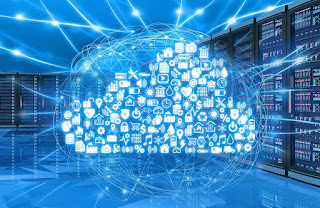How Can IoT Integrate with Cloud Computing ?
The extraordinary expansion of IoT is undeniable — there are over 10 billion active IoT devices in 2022, with that figure expected to rise to 25.4 billion by 2030. On the other hand, cloud technology is booming, with 83 % of corporate operations now on the cloud and 94% of businesses employing a cloud infrastructure.
IoT and cloud computing are expanding at a comparable pace since they share a symbiotic relationship. IoT devices create data, which must be gathered and interpreted locally or remotely. Remote data hosting and analytics are a more cost-effective and practical option in many IoT applications. The total quantity of data generated by IoT devices is estimated to reach 73.1 ZB (zettabytes) by 2025, necessitating massive computational capacity — which cloud computing can deliver.
Is the Internet of Things based on cloud computing?
In short yes. Using the cloud facilitates the processing to take place outside of the device, which is frequently hard or unreasonably expensive to perform on tiny devices or edge processors.
Let us take a deeper look at how IoT devices and cloud computing communicate.
To complete operations, IoT devices communicate with one another via networks. They are sometimes referred to as smart gadgets since they can monitor industrial processes, operate residential services such as lighting and HVAC systems remotely through a smartphone app, or measure soil moisture levels in agricultural areas.
Cloud is a term that refers to the remote storage and processing of vast volumes of data scattered among computers all over the world. A collection of IoT devices is frequently linked to remote storage and processing facilities in the cloud. As the devices gather data, they send it to a cloud server (either directly or using a local IoT gateway), where it may be monitored and evaluated via an online platform, which is often a smartphone app or webpage.
For example, IIoT sensors collect data to assess the safety and operation of the production line equipment. They route the data through a local gateway and send it to a central server, where it is combined and analyzed. C-level executives and offshore managers may then access data dashboards and reports on the operation of the machines, allowing them to evaluate the overall effectiveness of the smart facility.
What is the function of cloud technology in the Internet of Things (IoT) ?
As already discussed, cloud computing is important in many IoT systems. Let us take a closer look at how the cloud helps and offers an infrastructure for IoT deployments:
Storage Is Unlimited
As IoT devices generate real-time data — and many of them never stop generating it — storage capacity is a significant impediment for many applications. Cloud computing tackles this problem by providing almost unrestricted storage space, allowing businesses to keep continuous recordings of IoT data over time and providing more insights and reports on improved productivity and expansion.
Low-Cost Data Management
With the rise of big data, IoT devices typically generate just too much data that it would be challenging to store and handle everything at the edge. Cloud computing, with its limitless capacity, offers a practical and cost-effective alternative for data management. This lowers the overall costs for running an IoT setup since cloud providers handle all hardware resources, maintenance issues, and security upgrades.
Remote Monitoring Capabilities Have Been Upgraded
Dealing with massive volumes of data is beyond the capabilities of standard PCs or even advanced edge computing systems. Cloud computing infrastructure can provide the massive processing capacity required to handle data flooding in from IoT devices since it is based on virtual computers that replicate hardware elements. There are additional practical benefits to processing data remotely: it minimizes the requirement to acquire and store high-level gear, as well as provides electrical power for that technology.
Ample Scalability
As cloud computing utilizes components of pre-existing computers, a company may grow quickly by simply subscribing to additional cloud computation and storage capacity. If the demand fades away, they may just cut down the expenses. It is like renting an apartment with a monthly rent instead of buying a house.
Remote Collaboration
With a large community of developers participating in the planning and maintenance of an IoT deployment, remote cloud processing enables individuals working on innovative functionalities to interact with the devices and participate in coding and application development effortlessly. For example, if you utilize cloud computing resources to monitor the amount of excessive heat in manufacturing equipment, a designer may use that data to create a predictive algorithm to better manage the equipment's operation — and thereafter remotely adjust the devices to execute the innovative technique.
What Is the Future of Cloud Computing and IoT?
Edge computing — maintaining partial data processing capacity at the network edge rather than outsourcing everything to the cloud — is gaining popularity as IoT and cloud computing continue to grow. Edge computing has immense potential for real-time data processing, and it may assist reduce the demand for cloud storage by pre-filtering data and transmitting only a portion of it to faraway servers. However, because moving all data processing and storage back to the edge is impossible for most businesses, edge computing will coexist with IoT devices and cloud computing in the future, helping to deliver a comprehensive framework for the ever-increasing large datasets from gigantic IoT systems.




Comments
Post a Comment